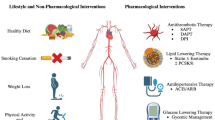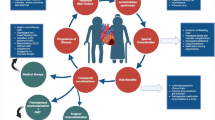Summary
We conducted a multicenter prospective, randomized, double-blind, placebo-controlled trial to test whether pravastatin, a hydroxymethyl glutaryl coenzyme A reductase inhibitor, can decrease restenosis after percutaneous transluminal coronary angioplasty (PTCA). Pravastatin 10 mg twice daily was begun at least 10 days prior to elective PTCA in patients with total cholesterol less than 280 mg/dl. The end-point was a between-group comparison of the frequency of restenosis defined as a more than 50% loss of the initial gain in diameter stenosis at the PTCA site at 3 months during follow-up by automated quantitative coronary arteriography. Of 207 patients randomly assigned to study groups, 139 patients underwent PTCA; 133 procedures were successful, and 124 patients underwent follow-up angiography at 3 months, and 179 lesions (85 pravastatin, 94 placebo) in 124 patients (62 pravastatin, 62 placebo) were analyzed. The two groups were comparable for baseline characteristics. Total cholesterol decreased by 19.6% in the pravastatin group (p<0.001) but not in the placebo group. Although the restenosis rate was not different in the two groups (29.4% in pravastatin vs. 39.4% in placebo, p=0.215) as a whole, it was reduced to about one fifth (8.8%) in the pravastatin group compared with 14.8% in the placebo group (p=0.0011) when the comparison was restricted to high grade lesions (≥75% diameter stenosis, 34 lesions in pravastatin, 29 lesions in placebo). Pravastatin thus reduces restenosis after PTCA of high grade lesions.
Similar content being viewed by others
References
Gruentzig AR, King SIII, Schlumpf M, Siegenthaler W. Long-term follow-up after percutaneous transluminal coronary angioplasty. The early Zurich experience. N Engl J Med 1987;316:1127–1132.
Detre K, Holubkov R, Kelsey S, et al. Percutaneous transluminal coronary angioplasty in 1985–1986 and 1977–1981: The National Heart, Lung, Blood Institute Registry. N Engl J Med 1988;318:265–270.
Leimgruber PP, Roubin GS, Hollman I, et al. Restenosis after successful coronary angioplasty in patients with single-vessel disease. Circulation 1986;73:710–717.
Kaltenbach M, Kober G, Scherer D, Vallbracht C. Recurrence rate after successful coronary angioplasty. Eur Heart J 1985;6:276–281.
Levine S, Ewels CJ, Rosing DR, Kent KM. Coronary angioplasty: Clinical and angiographic follow-up. Am J Cardiol 1985;55:673–676.
Holmes DJ, Vlietstra RE, Smith HC, et al. Restenosis after percutaneous transluminal coronary angioplasty (PTCA): A report from the PTCA Registry of the National Heart, Lung, and Blood Institute. Am J Cardiol 1984;53.
Bertrand ME, LaBlanche JM, Thieuleux FA, Fourrier JL, Traisnel G, Asseman P. Comparative results of percutaneous transluminal coronary angioplasty in patients with dynamic versus fixed coronary stenosis. J Am Coll Cardiol 1986;8:504–508.
Whitworth HB, Roubin GS, Hollman J, et al. Effect of nifedipine on recurrent stenosis after percutaneous transluminal coronary angioplasty. J Am Coll Cardiol 1986;8: 1271–1276.
Nobuyoshi M, Kimura T, Nosaka H, et al. Restenosis after successful percutaneous transluminal coronary angioplasty: Serial angiographic follow-up of 229 patients. J Am Coll Cardiol 1988;12:616–623.
Schwartz L, Bourassa MG, Lesperance J, et al. Aspirin and dipyridamole in the prevention of restenosis after percutaneous transluminal coronary angioplasty. N Engl J Med 1988;318:1714–1719.
Knudtson ML, Flintoft VF, Roth DL, Hansen JL, Duff HJ. Effect of short-term prostacyclin administration on restenosis after percutaneous transluminal coronary angioplasty. J Am Coll Cardiol 1990;15:691–697.
Pepine CJ, Hirshfeld JW, Macdonald RG, et al. A controlled trial of corticosteroids to prevent restenosis after coronary angioplasty. Circulation 1990;81:1753–1761.
Corcos T, David PR, Val PG, et al. Failure of diltiazem to prevent restenosis after percutaneous transluminal coronary angioplasty. Am Heart J 1985;109:926–931.
Reis GJ, Boucher TM, Sipperly ME, et al. Randomised trial of fish oil for prevention of restenosis after coronary angioplasty. Lancet 1989;2:177–181.
Multicenter European Research Trial with Cilazapril after Angioplasty to Prevent Transluminal Coronary Obstruction and Restenosis (MERCATOR) Study Group. Does the new angiotensin converting enzyme inhibitor cilazapril prevent restenosis after percutaneous transluminal coronary angioplasty? Results of the MERCATOR study: A multicenter, randomized, double-blind placebo-controlled trial. Circulation 1992;86:100–110.
Desmet W, Vrolix M, De SI, Van LJ, Willems JL, Piessens J. Angiotensin-converting enzyme inhibition with fosinopril sodium in the prevention of restenosis after coronary angioplasty. Circulation 1994;89:385–392.
Serruys PW, Klein W, Tijssen JP, et al. Evaluation of ketanserin in the prevention of restenosis after percutaneous transluminal coronary angioplasty. A multicenter randomized double-blind placebo-controlled trial. Circulation 1993; 88:1588–1601.
Gellman J, Ezekowitz MD, Sarembock IJ, et al. Effect of lovastatin on intimal hyperplasia after ballon angioplasty: A study in an atherosclerotic hypercholesterolemic rabbit. J Am Coll Cardiol 1991;17:251–259.
Sahni R, Maniet AR, Voci G, Banka VS. Prevention of restenosis by lovastatin after successful coronary angioplasty. Am Heart J 1991;121:1600–1608.
Friedewald WT, Levy RI, Frederickson DS. Estimation of the concentration of low density lipoprotein cholesterol in plasma without use of the preparative ultracentrifuge. Clin Chem 1972;18:499–508.
Nichols AB, Gabrieli CFO, Fenoglio JJJ, Esser PD. Quantification of relative coronary arterial stenosis by cinevideodensitometric analysis of coronary arteriograms. Circulation 1984;69:512–522.
Silver KH, Buczek JA, Esser PD, Nichols AB. Quantitative analysis of coronary arteriograms by microprocessor cinevideodensitometry. Cathet Cardiovasc Diagn 1987;13: 291–300.
AHA Committee Report. A reporting system on patients evaluated for coronary artery disease. Circulation 1975;51: 5–40.
Weintraub WS, Boccuzzi SJ, Klein JL, et al. Lack of effect of lovastatin on restenosis after coronary angioplasty. N Engl J Med 1994;331:1331–1337.
TLRC. The Lipid Research Clinics Coronary Primary Prevention Trial results, I: Reduction in incidence of coronary heart disease. JAMA 1984;251:351–364.
Frick MH, Elo O, Haapa K, et al. Helsinki Heart Study: Primary-prevention trial with gemfibrozil in middle-aged men with dyslipidemia. Safety of treatment, changes in risk factors, and incidence of coronary heart disease. N Engl J Med 1987;317:1237–1245.
Buchwald H, Varco RL, Matts JP, et al. Effect of partial ileal bypass surgery on mortality and morbidity from coronary heart disease in patients with hypercholesterolemia—report of the program on the surgical control of the hyperlipidemia (POSCH). N Engl J Med 1990;323:946–955.
The Pravastatin Multinational Study Group for the Cardiac Risk Patients. Effect of pravastatin in patients with serum total cholesterol levels from 5.2 to 7.8 mmol/liter (200 to 300 mg/dl) plus two additional atherosclerotic risk factors. Am J Cardiol 1993;72:1031–1037.
McPherson R, Bedard J, Connolly P, et al. Comparison of the short-term efficacy and tolerability of lovastatin and pravastatin in the management of primary hypercholesterolemia. Clin Ther 1992;14:276–291.
Leung WH, Lau CP, Wong CK. Beneficial effect of cholesterol-lowering therapy on coronary endothelium-dependent relaxation in hypercholesterolaemic patients. Lancet 1993; 341:1496–1500.
Egashira K, Hirooka Y, Kai H, et al. Reduction in serum cholesterol with pravastatin improves endothelium-dependent coronary vasomotion in patients with hypercholesterolemia. Circulation 1994;89:2519–2524.
Treasure CB, Klein JL, Weintraub WS, et al. Beneficial effect of cholesterol-lowering therapy on the coronary endothelium in patients with coronary artery disease. N Engl J Med 1995;332:481–487.
Lacoste L, Lam JYT, Hung J, et al. Hyperlipidemia and coronary disease. Correction of the increased thrombogenic potential with cholesterol reduction. Circulation 1995;92: 3172–3177.
The Scandinavian Simbastatin Survival Study Group. Randomized trial of cholesterol lowering in 444 patients with coronary heart disease: The Scandinavian Simbastatin Survival Study (4S). Lancet 1994;344:1383–1389.
Shepherd J, Cobbe SM, Ford I, et al. Prevention of coronary heart disease with pravastatin in men with hypercholesterolemia. N Engl J Med 1995;333:1301–1307.
Fenton RG, Kung HF, Longo DL, Smith MR. Regulation of intracellular action polymerization by prenylated cellular proteins. J Cell Biol 1992;117:347–356.
Detre KM, Wright E, Murphy ML, Takaro T. Observer agreement in evaluating coronary angiograms. Circulation 1975;52:979–986.
White CW, Wright CB, Doty DB, et al. Does visual interpretation of the coronary arteriograms predict the physiological importance of a coronary stenosis? N Engl J Med 1984;310:819–824.
Azuma A. Quantitative analyses of coronary arteriogram for assessment of percutaneous transluminal coronary angioplasty. J Kyoto Pref Univ Med 1994;103:659–676.
Author information
Authors and Affiliations
Consortia
Rights and permissions
About this article
Cite this article
Nakamura, Y., Yamaoka, O., Uchida, K. et al. Pravastatin reduces restenosis after coronary angioplasty of high grade stenotic lesions: Results of SHIPS (SHIga Pravastatin Study). Cardiovasc Drug Ther 10, 475–483 (1996). https://doi.org/10.1007/BF00051114
Received:
Accepted:
Issue Date:
DOI: https://doi.org/10.1007/BF00051114




